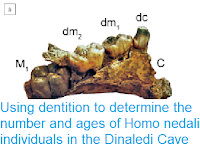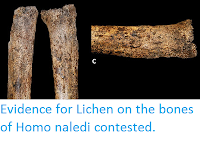Hominin remains from the Middle Pleistocene of Africa are rare, and those that do exist are often highly fragmentary, frustrating for scientists studying the origin of our own species. One notable, and dramatic, exception to this is the fossils of the Dinaledi Chamber of the Rising Star Cave system, part of the Maropeng Cradle of Humankind complex of caves in Gauteng State, to the northwest of Johannesburg, South Africa, where over 1550 pieces of bone belonging to at least fifteen individuals, were found within a single chamber, dated to between 335 000 and 236 000 years ago. These remains were used to describe a new species of Hominin, Homo naledi. This discovery has led to a renewed interest in the fragmentary remains of similar age found in other caves of similar age in the same area, including the Hominin teeth found in Lincoln Cave between 1997 and 2003, and Sterkfontein Cave L/63, which is undated, but contains similar artifacts and animal remains to Lincoln Cave.
In a paper published in the South African Journal of Science on 29 May 2019, Juliet Brophy of the Department of Geography and Anthropology at Louisiana State University, Joel Irish of the Research Centre in Evolutionary Anthropology and Palaeoecology at Liverpool John Moores University, Steve Churchill of the Department of Evolutionary Anthropology at Duke University, Darryl de Ruiter of the Department of Anthropology at Texas A&M University, John Hawks of the Department of Anthropology at the University of Wisconsin, and Lee Berger of the Evolutionary Studies Institute at the University of the Witwatersrand, present the results of a study which used morphometric analysis to compare the Lincoln Cave and Sterkfontein L/63 teeth to those of Homo naledi.
Morphometric
analysis is a tool used by palaeontologists, archaeologists,
anthropologists and forensic pathologists to analyse and compare
specimens. It relies on taking numerous measurements of an object
such as a bone or shell, and comparing both these measurements and
ratios between measurements to those obtained from other specimens in
order to establish relationships between them. Traditionally these
measurements have been obtained using tape measures and callipers,
but modern scientists often use more sophisticated tools such as
structured light scanners, which are capable of building highly
detailed three dimensional models of specimens.
The Lincoln Cave is located in the Lincoln-Fault Cave system adjacent to the Sterkfontein Cave system. It is divided in two by an old ramp made by limestone miners, named Lincoln Cave North and Lincoln Cave South. Lincoln Cave North, consists of calcified deposits while Lincoln Cave South is uncalcified. The cave dates to between 252 600 and 115 300 years ago based on uranium series dating of flowstones, dates comparable to the 335 000 to 236 000 years old estimated for the Dinaledi Chamber.
Flowstone is formed by the deposition of calcium carbonate onto surfaces
by evaporating water; typically water that has flowed through limestone
deposits then run out onto a surface such as a cave wall or cliff face
before evaporating. The most obvious examples of this are stalagmites
and stalactites, though many caves have an interior surfaces covered by
flowstone. Uranium-thorium dating works because uranium decays to thorium at a
known rate, so that the ratio of the two elements in minerals that
naturally incorporate uranium but not thorium can be used to establish a
date for the minerals. Neither uranium nor thorium are typically found
in carbonate deposits, but uranium can be absorbed into these minerals
as they form, whereas thorium cannot. Thus all the uranium and thorium in a sample of calcium carbonate will have been uranium when the deposit was laid down, and the ratio of the two elements can be used to date the rock (the more thorium there is, the older the rock).
Three Hominin teeth were recovered during the Lincoln Cave excavations, as well as a number of stone tools and a variety of animal remains. These are StW 591 is an unerupted permanent left upper first incisor, StW 592 an unerupted left maxillary first molar, and StW 593 a lower right first incisor. A single tooth was found during the excavation of Sterkfontein L/63, a a right maxillary canine identified as StW 585.
Brophy et al. were able to use two of these teeth for the study, StW 585, which was was directly compared with the Homo naledi maxillary permanent canines from the Dinaledi Chamber at the University of the Witwatersrand, and StW 592, which was compared with Homo naledi maxillary first molars based on the description, image and measurements given in their original description of the Lincoln Cave material by Reynolds et al. (2007).
Lingual view of StW 585 from L/63 area of Sterkfontein Cave (centre) and Homo naledi maxillary permanent canines from the Dinaledi Chamber. Left to right: U.W. 101-337 RC, U.W. 101-908 RC, StW 585 RC, U.W. 101-501 LC, U.W. 101-412 LC. Arrow shows large tuberculum dentale of StW 585. Brophy et al. (2019).
StW 585 and the Homo naledi maxillary permanent canines from the Dinaledi Chamber differ in significant ways. Lingually (on the inner side of the tooth), StW 585 has a large tuberculum dentale (a small elevation of variable size on the crown of a tooth representing a thickened area of enamel or an accessory cusp) while Homo naledi does not. The median lingual ridge of StW 585 divides the crown into small (mesial (front) and large distal (back) fossae (shallow depressions or hollows); while in the Homo naledi canines the mesial fossae is large and the distal fossae small. The distal crest of StW 585 is less convex than that of Homo naledi. StW 585 is more mesiodistally curved (the mesial and distal crown edge curve inward toward the midline of the tooth) than Homo naledi specimens such as U.W. 101-337. The crown of StW 585 is short and robust relative to its overall size while Homo naledi canines appear tall.
Labial view of StW 585 from L/63 area of Sterkfontein Cave (centre) and Homo naledi maxillary permanent canines from the Dinaledi Chamber. Left to right: U.W. 101-337 RC, U.W. 101-908 RC, StW 585 RC, U.W. 101-501 LC, U.W. 101-412 LC. Brophy et al. (2019).
The StW 585 and Homo naledi canines do share several traits, including, lingually, a mesial crest that is shorter than the distal crest, and a mesial shoulder that is more apically placed than the distal shoulder. The labial face is minimally curved incisocervically in both StW 585 and Homo naledi. All have a mesial crest that is more concave than the distal counterpart. Also, the mesial and distal labial grooves are weakly expressed in all canines. A deep groove runs along the mesial length of the root, with a shallow groove along the distal length. StW 585 falls within the absolute size range of variation for Homo naledi. While root length is not a conclusive feature for determining species, StW 585 overlaps in size with the Homo naledi sample.
Mesial view of StW 585 from L/63 area of Lincoln Cave (centre) and Homo naledi maxillary permanent canines from the Dinaledi Chamber. Left to right: U.W. 101-337 RC, U.W. 101-908 RC, StW 585 RC, U.W. 101-501 LC, U.W. 101-412 LC. Brophy et al. (2019).
StW 592 has a prominent C5 (fifth cusp), while Homo naledi maxillary first molars lack a C5 or other accessory cusps. The crista obliqua is continuous between the protocone and metacone (ridge connecting the front outer cusp and the back inner cusp) in Homo naledi, unlike StW 592. The StW 592 crown is larger than all Homo naledi upper first molars. Finally, StW 592 exhibits a more ‘bulbous’ morphology relative to Homo naledi U.W. 101-1305 or U.W. 101-1688.
Occlusal view of Homo naledi U.W. 101-1305 (left) and StW 592. Brophy et al. (2019).
Despite these differences, StW 592 and Homo naledi first molars share a similar size gradient of the principal cusps: the protocone (outer front cusp) is larger than the hypocone (outer back cusp), which in turn is larger than the metacone and the paracone (inner back and front cusps), which are roughly the same size. In addition, occlusal outlines of the StW 592 and Homo naledi molars are rhomboidal with a distolingual projection of the hypocone (projection from the back inner side of the outer back cusp).
Based upon this analysis, Brophy et al. conclude that the Lincoln Cave and L/63 teeth, despite some parallels in depositional and post-depositional contexts, are inconsistent with known samples of Homo naledi. If there is overlap in time, the results would suggest that more than one species of Homo was present in the Late Middle Pleistocene of South Africa. If not, the Lincoln Cave and L/63 teeth may represent an earlier species of Homo. Unfortunately, given the uncertainty of the dates, at present the Lincoln Cave and L/63 teeth offer little support for either scenario.
See also...
Follow Sciency Thoughts on Facebook.










